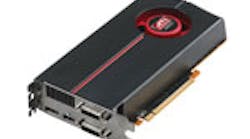AMD ATI HD5770 holds 800 stream processors
Supports multi-display Eyefinity technology
The ATI HD5770 is AMD’s mid range. It has 800 stream processors compared to the 1600 found in the HD5870. The top end is a dual-GPU HD5970 that doubles the HD5870 performance. The HD5770 is a step up from the HD5670 that has 400 stream processors. Both plug into PCI Express x16 slots.
The HD5670 is a sub-$100 solution that runs at 775 MHz. It uses 128-bit GDDR5 memory with a 1GHz clock rate and is available in 512 Mbyte and 1 Gbyte configurations. Its TDP is only 61W and 14W in idle or desktop mode. The low power numbers are critical for those looking to upgrade since the power supply is often more limited than on high end gaming machines. The HD5670 is also a shorter card and does not require an additional power cable.
The HD5770 has a 128-bit memory bus compared with the 256-bit bus found on the higher end systems. Its 850MHz clock rate and 1.2 GHz GDDR5 matches that found in the higher end systems as does the 1 Gbyte of video memory. Of course, this does give a cooler 108W TDP and only 18W in idle mode.
The HD5770 was one of the first boards to handle Microsoft’s DirectX 11 that is key to features found in the latest 3D games. The HD5670 was released in 2010 and was the first to deliver this support for less than $100. DirectX 11 improves the multithreading support that can come in handy for more sophisticated games especially ones that might take advantage of three displays that the HD5770 is capable of handling courtesy of ATI’s Eyefinity angle-independent anisotropic filtering. Eyefinity allows mixing different display sizes and resolutions, very useful when adding or upgrading in a mixed display environment. Most HD5670 boards will support 3 displays but some can handle up to four displays. HDMI 1.3 support complements the DVI and VGA display support found on the boards. The HDMI link delivers Dolby True HD and DTS Master Audio support.
Both support ATI’s Stream Processing, DirectX 11 DirectCompute, and OpenCL. These can be used to accelerate everything from streaming video decode of Adobe’s Flash player and Blu-ray movies to facial recognition analysis.
The HD5770 and the HD5670 support ATI CrossfireX. This allows multiple boards to work together on the same video stream. It provides an incremental upgrade path.
Performance is the key to choosing between the two. Heavy duty gamers may want to go with the dual GPU HD5970 but the HD5770 and HD5670 can handle anything that runs on the HD5970. The tradeoff will be in frame rate and possibly resolution. For casual gamers and regular users the HD5670 is the best bang for the buck. The HD5770 is just the thing for better gaming performance without breaking the bank.


